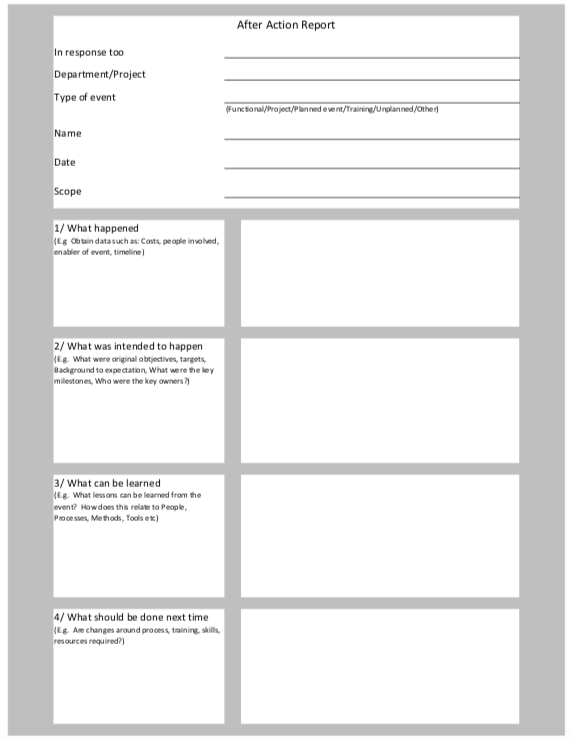
In this post, we’re going to look at how to create an After Action Review template. We’ll also take a look at the After Action Review process, what’s great about it, how you can use it in your business and a few things to watch out for along the way.
What is the Action Review Process, and where does the template fit in?
For organizations to continually improve, they must look at their successes and failures and use this information to help inform and educate their organization, and it’s processes.
When an event happens, businesses are often faced asking themselves “What happened”, “Why has it happened”, “What can be learned for next time?”.
To answer these questions (and more) a business needs a standard process designed to ask the right questions capturing information before sharing it with the rest of the organization.
Why do this? So that best practice can be captured and shared.
The US Army originally developed the After Action Review process as a means of rapidly obtaining information from staff in a way that could be shared easily.
After Action Review (AAR) follows a set structure that offers a method of evaluating an event (such as within a project or if a particular business issue arises), the process helps capture what worked and what didn’t.
The After Action Review template is a document that is used to capture the output of the process.
Where would you use After Action Report?
Examples of where you might use the After Action Reporting process:
- Developing a product prototype
- As a review gate following the introduction of a new process
- When implementing a new manufacturing process.
- Project milestones / or End of Project
- Health & Saftey Incidents
- Customer Complaints
The AAR helps to identify lessons that can be learned and as a result, help identify improvement opportunities. A key benefit is that the process provides a mechanism of capturing these quickly so that they are rapidly shared with the broader business.
It sounds a little like a 5 why to me?
After Action reports do share some DNA with other problem solving and root cause methods; however, this tool focuses on capturing people’s experience of projects/issues and looks to focus on lessons learned rather than root causes.
Why should you use it?
An After Action Review (AAR) has several benefits, including:
- Facilitates participation from a wider team
- Doesn’t focus on blame
- Captures ideas for improvements
- Focus’s on key differences between should be and as is, helping the team to understand precisely the gaps in performance
- Helps to identify both
- Potential areas for improvements
- Things that have gone well which could benefit other areas of the business.
How to create an After Action Review Template
Ok, having reviewed the process, let’s have a look at how to create an After Action Review Template.
Our personal preference when we create forms like this is to use Excel, but you can easily use a Word Processor like MS Word or Google Docs.
Let’s first have a look at our finished template, you can see it below, and then we’ll go into how we constructed it.

There are 5 basic sections:
1/ Document Header
2/ What Happened Section
3/What was intended to happen Section
4/ What can be learned Section
5/ What should be done next time section
As the document is intended merely for capturing the outputs of discussions, there’s no need for formulae’s and the template can be created using regular formatting.
The template is relatively simple, and we envisage it as a printable document that could be printed for use ahead of any meetings.
Let’s take a look at each of the sections:
1/ The header

In the header we created 6 fields to capture various chunks of data relating to the form.
- “In response too” – This field captures the reason why we are filling out the form
- “Department/Project” – captures information about the user
- “Type of event” – Captures the information around the type of event, note that under the field we’ve given some examples of allowable entries for this field – these include Function, Project, Unplanned.
- “Name” & “Date” – Captures further information about the user and the date the form was updated
- “Scope” – Allows the user to enter some information about the scope of the event.
The next three sections are designed as boxes that the user enters information into. To the left, we document the questions being asked (with some information and examples), to the right of this, we’ve got a text box to record the answer(s).
2/ “What happened” – this box allows the user to enter information about what happened, this could include a range of information from costs, people etc

3/ “What was intended to happen” This box requires information the “should be” state. For this section its best to capture data/measures. Using figures gives a precise condition that should’ve been achieved.

4/ ” What can be learned” – This box captures lessons learned. The information captured here can be part of future training information for other colleagues. As a result, you must capture specifics that can be flowed out to your organization.

5/ “What should be done next time” – This section captures information about what changes (if any) should be made and utilized in the case of the event arising next time. Once again, this may feature information about changes to things like process, resources, skills etc.).

How does the After Action Review Process work.
The process usually follows a number of steps which are:
1/ Appoint a facilitator
2/ Determine how you will capture the results and establish a timeframe.
3/ Determine the audience that will participate
4/ The team follow the process inputs asking:
- What was supposed to happen
- What actually happened
- Why was there a difference
- What can be learned
5/ Agree follow up actions/owners
6/ Agree what lessons learned are to be shared with the business
7/ Share lessons learned with the business
Why should you use the After Action Review process?
The After Action Review process offers several benefits and sits nicely within the arsenal of continuous improvement tools, benefits include:
- It forms part of a continuous improvement/learning culture.
- Allows the team to participate
- Doesn’t focus on blame but on sharing information
- Facilitates discussion on goals vs. results
- Facilitates the flow of positive practices within an organization
What are the common issues/problems associated with the process?
As with all processes there are some things to watch out for, these include:
- A skilled facilitator is required
- Requires active participation from all of the invited audience
- If the process is conducted too long after event, key facts may have been forgotten
- People might fear punishment through speaking up and therefore, not contribute.
- Lesson’s that are learned are not incorporated into company process
- Subjectivity and experience are encouraged which can lean towards incorrect results
- Typical issues around brainstorming (loudest voice led)
Summary
We hope you found our write up of the process useful, and we hope that you put your own After Action Review Template into work and try the method out.
As with all continuous improvement processes, the key is that information on best practice is shared within the organization. We think After Event is a great method for doing this.
Do make sure that you check out our great Problem Solving guide, it’s full of tips, templates and how-to’s.
We’d love to hear some feedback; perhaps you have experience of using the process in your business? Feel free to use our comments section below or fire us a message on Twitter.